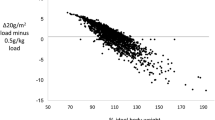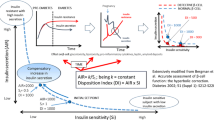Abstract
Intravenous glucose tolerance test (IVGTT) provocations are informative, but complex and laborious, for studying the glucose-insulin system. The objective of this study was to evaluate, through optimal design methodology, the possibilities of more informative and/or less laborious study design of the insulin modified IVGTT in type 2 diabetic patients. A previously developed model for glucose and insulin regulation was implemented in the optimal design software PopED 2.0. The following aspects of the study design of the insulin modified IVGTT were evaluated; (1) glucose dose, (2) insulin infusion, (3) combination of (1) and (2), (4) sampling times, (5) exclusion of labeled glucose. Constraints were incorporated to avoid prolonged hyper- and/or hypoglycemia and a reduced design was used to decrease run times. Design efficiency was calculated as a measure of the improvement with an optimal design compared to the basic design. The results showed that the design of the insulin modified IVGTT could be substantially improved by the use of an optimized design compared to the standard design and that it was possible to use a reduced number of samples. Optimization of sample times gave the largest improvement followed by insulin dose. The results further showed that it was possible to reduce the total sample time with only a minor loss in efficiency. Simulations confirmed the predictions from PopED. The predicted uncertainty of parameter estimates (CV) was low in all tested cases, despite the reduction in the number of samples/subject. The best design had a predicted average CV of parameter estimates of 19.5%. We conclude that improvement can be made to the design of the insulin modified IVGTT and that the most important design factor was the placement of sample times followed by the use of an optimal insulin dose. This paper illustrates how complex provocation experiments can be improved by sequential modeling and optimal design.



Similar content being viewed by others
References
Agerso H, Vicini P (2003) Pharmacodynamics of NN2211, a novel long acting GLP-1 derivative. Eur J Pharm Sci 19:141–150
Landersdorfer CB, Jusko WJ (2008) Pharmacokinetic/pharmacodynamic modelling in diabetes mellitus. Clin Pharmacokinet 47:417–448
Lundbaek K (1962) Intravenous glucose tolerance as a tool in definition and diagnosis of diabetes mellitus. Br Med J 1:1507–1513
Bergman RN, Lovejoy JC (1997) The minimal model approach and determinants of glucose tolerance. Louisiana State University Press, Baton Rouge
Bergman RN, Ider YZ, Bowden CR, Cobelli C (1979) Quantitative estimation of insulin sensitivity. Am J Physiol 236:E667–E677
Beard JC, Bergman RN, Ward WK, Porte D Jr (1986) The insulin sensitivity index in nondiabetic man. Correlation between clamp-derived and IVGTT-derived values. Diabetes 35:362–369
Yang YJ, Youn JH, Bergman RN (1987) Modified protocols improve insulin sensitivity estimation using the minimal model. Am J Physiol 253:E595–E602
Welch S, Gebhart SSP, Bergman RN, Phillips LS (1990) Minimal model analysis of intravenous glucose tolerance test-derived insulin sensitivity in diabetic subjects. J Clin Endocrinol Metab 71:1508–1518
Cobelli C, Ruggeri A (1991) A reduced sampling schedule for estimating the parameters of the glucose minimal model from a labeled IVGTT. IEEE Trans Biomed Eng 38:1023–1029
Vicini P, Cobelli C (2001) The iterative two-stage population approach to IVGTT minimal modeling: improved precision with reduced sampling. Intravenous glucose tolerance test. Am J Physiol Endocrinol Metab 280:179–186
Silber HE, Jauslin PM, Frey N, Gieschke R, Simonsson USH, Karlsson MO (2007) An integrated model for glucose and insulin regulation in healthy volunteers and type 2 diabetic patients following intravenous glucose provocations. J Clin Pharmacol 47:1159–1171
Foracchia M, Hooker A, Vicini P, Ruggeri A (2004) PopED a software for optimal experiment design in population kinetics. Comput Methods Programs Biomed 74:29–46
Retout S, Duffull S, Mentre F (2001) Development and implementation of the population Fisher information matrix for the evaluation of population pharmacokinetic designs. Comput Methods Programs Biomed 65:141–151
Retout S, Mentre F (2003) Further developments of the Fisher information matrix in nonlinear mixed effects models with evaluation in population pharmacokinetics. J Biopharm Stat 13:209–227
Dansirikul C, Silber HE, Karlsson MO (2008) Approaches to handling pharmacodynamic baseline responses. J Pharmacokinet Pharmacodyn 35:269–283
Beal SL, Sheiner LB, Boeckmann AJ (1989–2006) NONMEM users guides. Icon Development Solutions, Ellicott City, MD
Nyberg J, Karlsson MO, Hooker AC (2009) Simultaneous optimal experimental design on dose and sample times. J Pharmacokinet Pharmacodyn 36:125–145
Dodds MG, Hooker AC, Vicini P (2005) Robust population pharmacokinetic experiment design. J Pharmacokinet Pharmacodyn 32:33–64
Dokoumetzidis A, Aarons L (2007) Bayesian optimal designs for pharmacokinetic models: sensitivity to uncertainty. J Biopharm Stat 17:851–867
Pronzato L, Walter E (1985) Robust experiment design via stochastic approximation. Math Biosci 75:103–120
Tod M, Mentre F, Merle Y, Mallet A (1998) Robust optimal design for the estimation of hyperparameters in population pharmacokinetics. J Pharmacokinet Biopharm 26:689–716
Author information
Authors and Affiliations
Corresponding author
Rights and permissions
About this article
Cite this article
Silber, H.E., Nyberg, J., Hooker, A.C. et al. Optimization of the intravenous glucose tolerance test in T2DM patients using optimal experimental design. J Pharmacokinet Pharmacodyn 36, 281–295 (2009). https://doi.org/10.1007/s10928-009-9123-y
Received:
Accepted:
Published:
Issue Date:
DOI: https://doi.org/10.1007/s10928-009-9123-y




